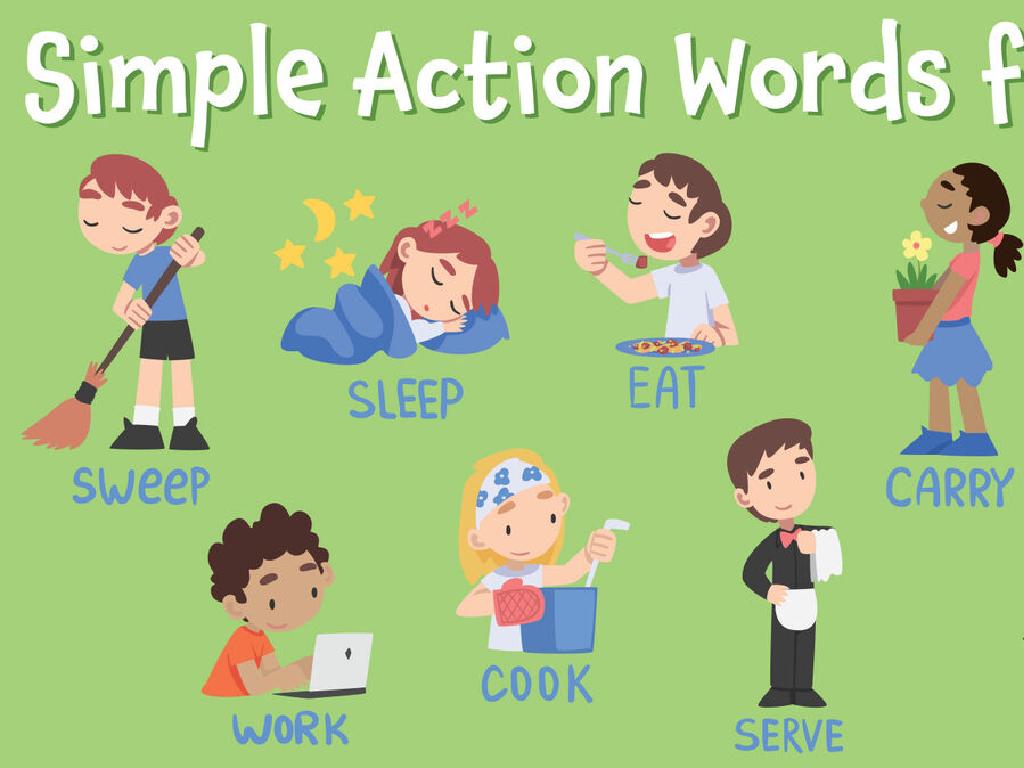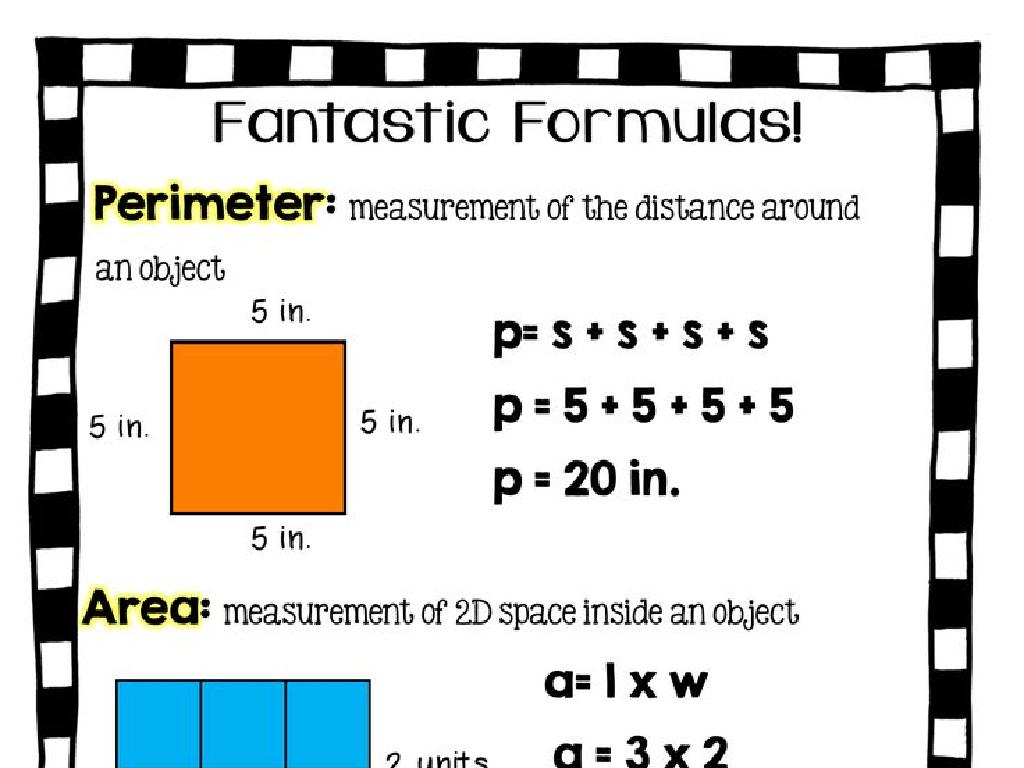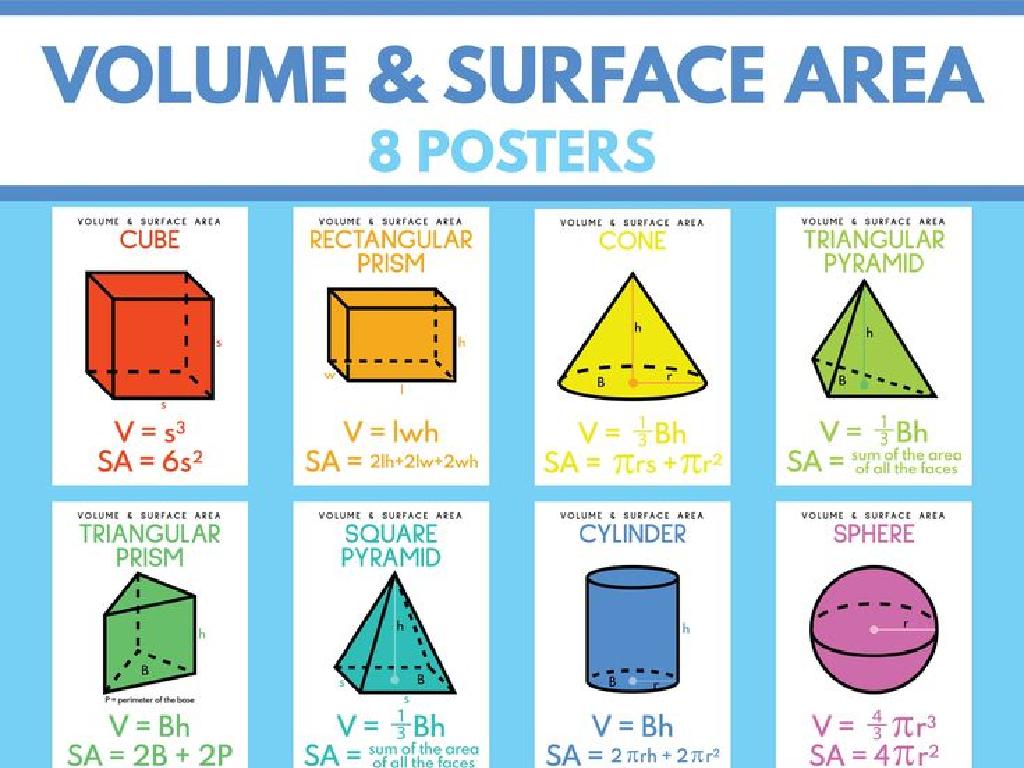Addition And Subtraction Word Problems
Subject: Math
Grade: Kindergarten
Topic: Mixed Operation Word Problems
Please LOG IN to download the presentation. Access is available to registered users only.
View More Content
Math Adventures: Becoming Math Detectives!
– Introduction to Math Detectives
– Solve mysteries with addition
– Find out how many apples are left after some are eaten.
– Solve mysteries with subtraction
– Discover how many more cookies are needed for the party.
– Use counting skills for clues
|
This slide is designed to excite Kindergarten students about using addition and subtraction in real-world scenarios. Begin by explaining that they will be Math Detectives, solving mysteries by finding missing numbers. Use simple and relatable scenarios such as adding apples in a basket or subtracting cookies eaten at a party to illustrate these concepts. Encourage the students to use their fingers or objects to count and find the answers. This interactive approach will help them understand the practical application of math in everyday life. Prepare to guide them through each problem and praise their efforts as they become more confident in their counting and problem-solving skills.
Understanding Word Problems
– Word problems are number stories
– Find out what the story asks
– Is the story about putting together or taking apart?
– Clues help us solve problems
– Look for words like ‘total’, ‘left’, ‘more’, ‘less’
– Practice with addition and subtraction
|
This slide introduces Kindergarten students to the concept of word problems in math, which are essentially stories that involve numbers. The goal is to help students understand that they need to read carefully to determine whether they should add or subtract. Teachers should emphasize the importance of looking for keywords or phrases in the problem that indicate which operation to use. For example, ‘in all’ or ‘altogether’ might suggest addition, while ‘left’ or ‘fewer’ might suggest subtraction. Use simple, relatable examples to illustrate these points, such as combining groups of objects or separating them. Encourage students to practice with real-life scenarios to reinforce the concept.
Understanding Addition
– Addition means combining
– Use the plus sign (+) for addition
– Example with apples
– If you have 2 apples and get 3 more, how many do you have now?
– Adding gives a total amount
– When we add 2 and 3, we count them all together to find the total.
|
This slide introduces the concept of addition to Kindergarten students. Start by explaining that addition is simply the process of putting things together to find out how much there is in total. Show the plus sign (+) and explain that it’s a special symbol we use when we want to add things. Use tangible examples like apples to illustrate addition in a way that’s relatable to the students. For instance, if you have 2 apples and someone gives you 3 more, you can count all the apples together to find out the total number you have. Encourage the students to use their fingers or objects to practice adding numbers together to reinforce the concept.
Understanding Subtraction
– Subtraction means take away
– Use minus sign (-) for subtraction
– Example with balloons
– If you start with 5 balloons and 2 fly away, how many are left?
– Practice with real objects
– Use toys or fingers to subtract
|
This slide introduces the concept of subtraction to Kindergarten students. Subtraction is explained as the process of taking things away, and the minus sign is introduced as the symbol used to represent this operation. Use a simple and relatable example, such as balloons, to illustrate subtraction: if you have 5 balloons and 2 fly away, you’re left with 3 balloons. Encourage students to practice subtraction using real objects they can touch, such as toys or their own fingers, to reinforce the concept. During the class, have different subtraction scenarios ready and guide the students through the process of ‘taking away’ to find the answer.
Reading Word Problems Together
– Understand the word problem
– Identify numbers and keywords
– Look for ‘in all’, ‘left’, and numbers
– Practice reading out loud
– Solve the problem step by step
– Use objects to visualize the problem
|
This slide is aimed at helping Kindergarten students approach addition and subtraction word problems by reading them out loud together. Start by explaining that a word problem tells a story we can solve with math. Emphasize the importance of understanding the problem before trying to solve it. Teach them to identify numbers and keywords such as ‘in all’ for addition and ‘left’ for subtraction, which give clues about the operation needed. Practice reading word problems as a class to build confidence. Use visual aids like counters or drawings to help them visualize the problem and understand the steps to find the solution. Encourage students to explain their thinking and how they arrived at their answers.
Adding Stars Together
– Use fingers to count additions
– Example: 3 stars + 2 stars
– Adding 3 stars to 2 stars, let’s count: 1, 2, 3… and then 4, 5.
– Count all stars together
– Put all the stars in a group and count them one by one.
– How many stars in total?
– After counting, we find the total number of stars.
|
This slide introduces kindergarteners to the concept of addition by using a simple and relatable example of counting stars. Encourage the students to use their fingers to count, which is a practical and visual way to understand addition. Start with the example provided and guide them through the process of counting on from the larger number. This method helps them visualize the concept of ‘adding more’ to a group. After the example, ask the students to try counting with their fingers for different numbers of stars or other objects. The goal is to make them comfortable with the idea of combining two groups to find a total. For the activity, you can provide different scenarios or use physical objects like counters or drawings to practice addition.
Solving Subtraction Problems
– Use fingers to count for subtraction
– Example: 5 candies – 3 candies
– Start with 5 fingers up, put 3 down
– Take away 3 candies
– Subtracting means taking away
– How many candies are left?
– Count the fingers that are still up
|
This slide introduces the concept of subtraction to Kindergarten students using a relatable and tangible method: counting with fingers. Begin by explaining that subtraction is like taking away. Show them how to start with a certain number of fingers (5 for the example) and then put down the number of fingers that are being taken away (3 for the example). Ask the students to perform the action themselves and then count the number of fingers they have left up. This hands-on activity helps them visually and physically understand the concept of subtraction. Encourage the students to practice with different numbers and use other examples of subtraction in everyday life. The goal is to make them comfortable with the idea of ‘taking away’ and understanding that subtraction tells us how many things are left.
Let’s Practice Together: Solving Word Problems
– Teamwork to solve a problem
– Look for story clues
– Words like ‘altogether’ or ‘left’ can be clues.
– Use pictures for help
– Drawings can represent numbers in the problem.
– Count with our fingers
– Our fingers are great for adding or taking away.
|
This slide is designed to engage Kindergarten students in a collaborative problem-solving activity. Start by presenting a simple addition or subtraction word problem. Encourage the students to listen carefully to the story and look for keywords that indicate whether to add or subtract. Use visual aids like pictures or objects to represent the problem, which will help them visualize the concept. Guide them to use their fingers to count as they work through the problem, reinforcing their understanding of the operations. The goal is to make the learning process interactive and fun, while also teaching them practical strategies for tackling word problems.
Math Detective Game: Treasure Hunt
– Become Math Detectives today
– Solve word problems to find treasure
– Use addition and subtraction clues to unlock the mystery
– Team up with classmates
– Help each other as detectives
– Share ideas and solve problems together
|
This class activity transforms the classroom into a fun and interactive treasure hunt where students work as Math Detectives. Provide a series of word problems that involve addition and subtraction, which will serve as clues leading to the ‘hidden treasure’. Encourage teamwork by having students collaborate in small groups. As they solve each problem, they get closer to the treasure. This activity promotes problem-solving skills, cooperation, and the practical application of math in a fun, engaging way. Possible activities: 1) Decoding a secret message with numbers, 2) Solving puzzles that reveal a location in the classroom, 3) A scavenger hunt where each clue requires solving a math problem, 4) A map with math problems that guide to different ‘treasure’ spots, 5) Creating their own word problems for peers to solve.
Celebrating Our Math Detectives!
– Congratulations on your hard work
– You are incredible Math Detectives
– Practice is key to success
– The more you solve, the better you get!
– Keep exploring numbers every day
– Try counting toys, steps, or even snacks!
|
This slide is meant to wrap up the lesson on addition and subtraction word problems by celebrating the students’ efforts and encouraging them to continue practicing. Reinforce the idea that they are ‘Math Detectives’ who can solve mysteries by using their math skills. Emphasize the importance of regular practice in mastering these concepts and suggest fun ways they can incorporate math into their daily lives, like counting objects around them. This positive reinforcement helps build their confidence and fosters a love for learning math.






